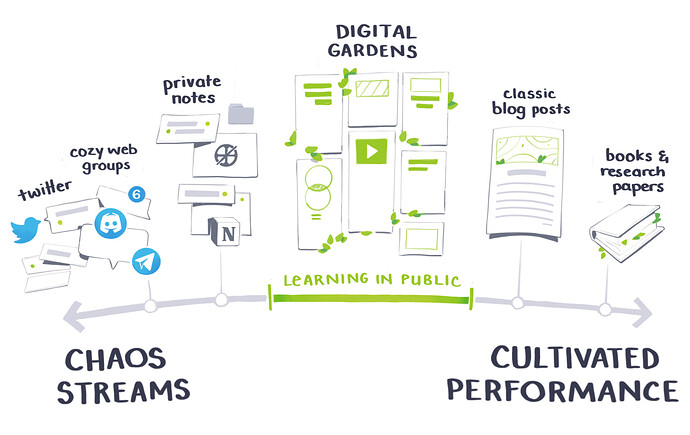Interested to follow this thread, thanks for posting. I’m curious how people are using the publishing feature (paid) of Obsidian, it’s an interesting concept.
You may know this, but in case not: Andy Matuschak (former research head at Khan Academy) publishes his ‘notes’ using Obsidian… as a sort of work in progress/best thinking (so far) on topics he’s researching and thinking about. It’s a useful reference point that may help you.
My own thoughts so far:
- I’m considering this question too, and will at some point probably create a public set of published notes using the Obsidian paid service
- In Malcolm Gladwell’s “Masterclass” on writing, he makes a helpful distinction in his writing workflow between “thinking” and “talking” that might provide a useful way to think about what is ‘ready’ for public consumption versus what you might want to keep private.
Gladwell’s Thinking and Talking Distinction
A quick summary, with a caveat: Gladwell is a journalist and best-selling non-fiction author, so his standard of what constitutes a “shareable” piece of writing is very high!
That said, for Gladwell he says that something he is “Talking About” is the product of a lot of “Thinking” that was previously done to iron out the kinks and make his “Talking” as compelling as possible, as well as easy to follow and understand. For him, something that he is still “Thinking About” is usually VERY HARD TO TALK ABOUT.
By “hard to talk about” he means his thinking is still confused and changing. He may not be able to find the words. Or he may be misunderstood when he tries to ‘talk about’ the thing he’s still thinking about. It might come out jumbled, long-winded, or just plain wrong (as in, even he might not agree with himself).
This might sound a simplistic distinction, but I think it’s actually profound. The point Gladwell is making is that we only really know what we think and believe, by writing about or orally expressing it and then continually refining it. With “use” over time the ideas we’re thinking about take form and shape, as they make more sense to ourselves. If you like, the “story” starts to mature.
My Take-away
Matuschak takes a different view from Gladwell, because he’s explicit about the fact that his thinking is not yet finished. He’s sharing his research and “thinking process” rather than a finished product. Moreover, this is consistent with Matuschak’s personal brand as a researcher: he wants to be known as being at the leading edge of current thinking and practice in his field. And he’s already established as an expert in his field, so he has credibility sharing his thoughts about where the field is going.
Gladwell, by contrast, is selling his opinions. His personal brand is as an opinion-maker who shapes the thinking of others. His thinking needs therefore to be polished, and he prides himself in his story-telling. His “product” of thinking is very refined, entertaining and easy to follow.
So in other words, I think the answer to your question depends on the personal brand that you want to project. Do you want to share “refined thinking” or “thinking in progress” with your audience?
If your audience is looking to you for what we might traditionally think of as “expertise” then I would suggest the Gladwell approach is the better one. An audience tends to turn to experts when they want “answers” which are credible and in some way judged to be “right.”
Alternatively, if your audience is perhaps more sophisticated/advanced in your subject matter, and if they will think for themselves (whatever you say), then you might want to expose your “work in progress” as food for thought, inspiration, provocation etc. In this case, like Matuschak, you are positioning yourself as an explorer in a new field or of an as-yet-unsolved problem. In this case, others will find your thought process itself compelling and valuable.
